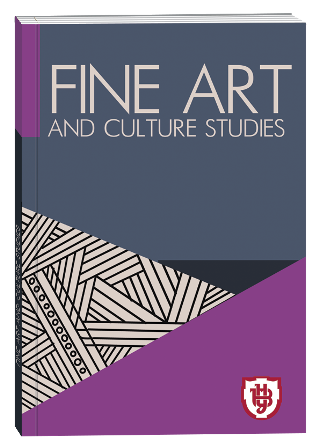BINAURAL BEATS IN MUSIC THERAPY: SOURCE SCIENCE ASPECT
DOI:
https://doi.org/10.32782/facs-2023-1-12Keywords:
binaural rhythms, music therapy, meditation, STAI, alpha waves, theta waves, beta waves, cognitive functions, attention, neurofeedbackAbstract
This article reviews the leading research on binaural beats and their potential applications in music therapy. Using binaural beats in music has shown positive effects on cognitive abilities, mood, stress, anxiety, and even physical pain. In addition, the integration of binaural rhythms into various forms of musical compositions has shown the potential to promote healing and self-discovery, which positively affects the listener’s well-being and quality of life. A cross-cutting problem of the research is the lack of standardization and consistency in the use of binaural rhythms in music. The binaural rhythms used in music vary greatly in frequency, duration, and intensity, making it difficult to compare and replicate the results of different studies. In addition, individual differences in sensitivity and response to binaural beats may also affect the results of the study. The specified limitations and problems need to be solved for the further development of this field of research. The methodological basis of the research is special and general scientific methods: bibliographic heuristics, analysis that allows you to find relevant literature and determine the scientific discussion; description – allows you to analyze in detail the influence of binaural rhythms on the synchronization of brain waves; integrative – allows you to get a complete picture of the influence of binaural rhythms on a person; logical-semantic for defining the essence of the concept of "binaural rhythms». The paper identifies binaural rhythms in music as a promising area of research with potential applications for enhancing cognitive performance, promoting relaxation, reducing stress and anxiety, and promoting healing. Although there are still challenges to be solved, a growing body of research into binaural beats in music suggests that this technology could have far-reaching implications for music therapy.
References
American Music Therapy Association. What is music therapy? 2015. URL: https://www.musictherapy.org/about/musictherapy/ (дата звернення: 15.02.2023).
Colzato L. S., Barone H., Sellaro R., Hommel B. More attentional focusing through binaural beats: evidence from the global–local task. Psychological Research, 2017. Vol. 81. №2. P. 271–277.
Gao X., Cao H., Ming D., Qi H., Wang X., Chen R., Zhou P. Analysis of EEG Activity in Response to Binaural Beats with Different Frequencies. International Journal of Psychophysiology, 2014. Vol. 94. №3. P. 399–406.
Gruzelier J., Egner T. Critical validation studies of neurofeedback. Child and Adolescent Psychiatric Clinics, 2005. Vol. 14. №1. P. 83–104.
García-Argibay M., Santed M. A. Efficacy of binaural auditory beats in cognition, anxiety, and pain perception: a meta-analysis. Journal of Medical Systems, 2019. Vol. 83. P. 357–372
Isik B. K., Esen A., Büyükerkmen B., Kilinç A., Menziletoglu D. Effectiveness of binaural beats in reducing preoperative dental anxiety. British journal of oral & maxillofacial surgery, 2017. Vol. 55. №6. P. 571–574.
Kennerly R. C. An empirical investigation into the effect of beta frequency binaural beat audio signals on four measures of human memory. Journal of alternative and complementary medicine, 1994. Vol.1. № 3. P. 293–299.
Lane J. D., Kasian S. J., Owens J. E., Marsh G. R. Binaural auditory beats affect vigilance performance and mood. Physiology & Behavior, 1998. Vol. 63. №2. P. 249–252.
Le Scouarnec R. P., Poirier R. M., Owens J. E., & Gauthier J. Use of binaural beat tapes for treatment of anxiety: a pilot study of tape preference and outcomes. Alternative therapies in health and medicine, 2001. Vol. 7. №1. P. 58–63.
Oster G. Auditory beats in the brain. Scientific American, 1973. Vol. 229. №4. P. 94–102.
Padmanabhan R., Hildreth A. J., Laws D. A prospective, randomised, controlled study examining binaural beat audio and pre-operative anxiety in patients undergoing general anaesthesia for day case surgery. Anaesthesia, 2005. Vol. 60. №9. P. 874–877.
Reedijk S. A., Bolders A., Hommel B., de Vries J. The impact of binaural beats on creativity. Frontiers in Human Neuroscience, 2013. Vol. 7. Article 786. P. 1–7.
Travis F., Shear J. Focused attention, open monitoring and automatic self-transcending: Categories to organize meditations from Vedic, Buddhist and Chinese traditions. Consciousness and cognition, 2010. Vol. 19. №4. P. 1110–1118.
Wahbeh H., Calabrese C., Zwickey H. Binaural beat technology in humans: a pilot study to assess psychologic and physiologic effects. The Journal of Alternative and Complementary Medicine, 2007. Vol. 13. №1. P. 25–32.







